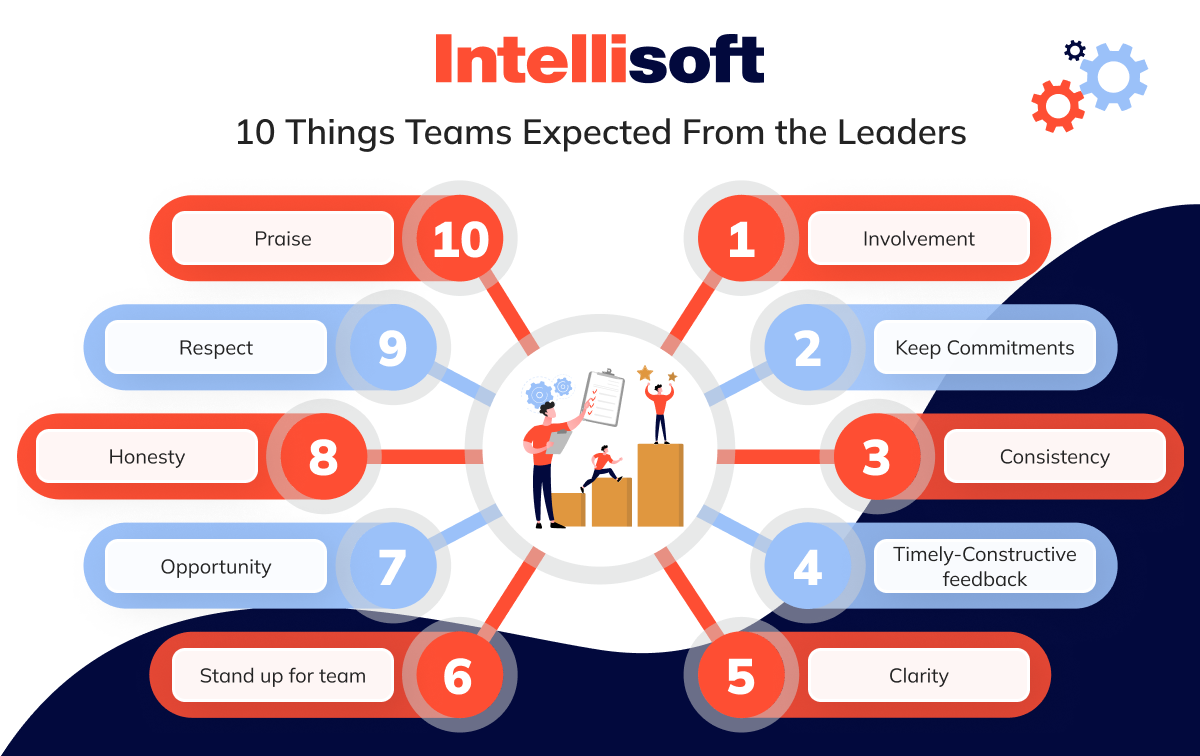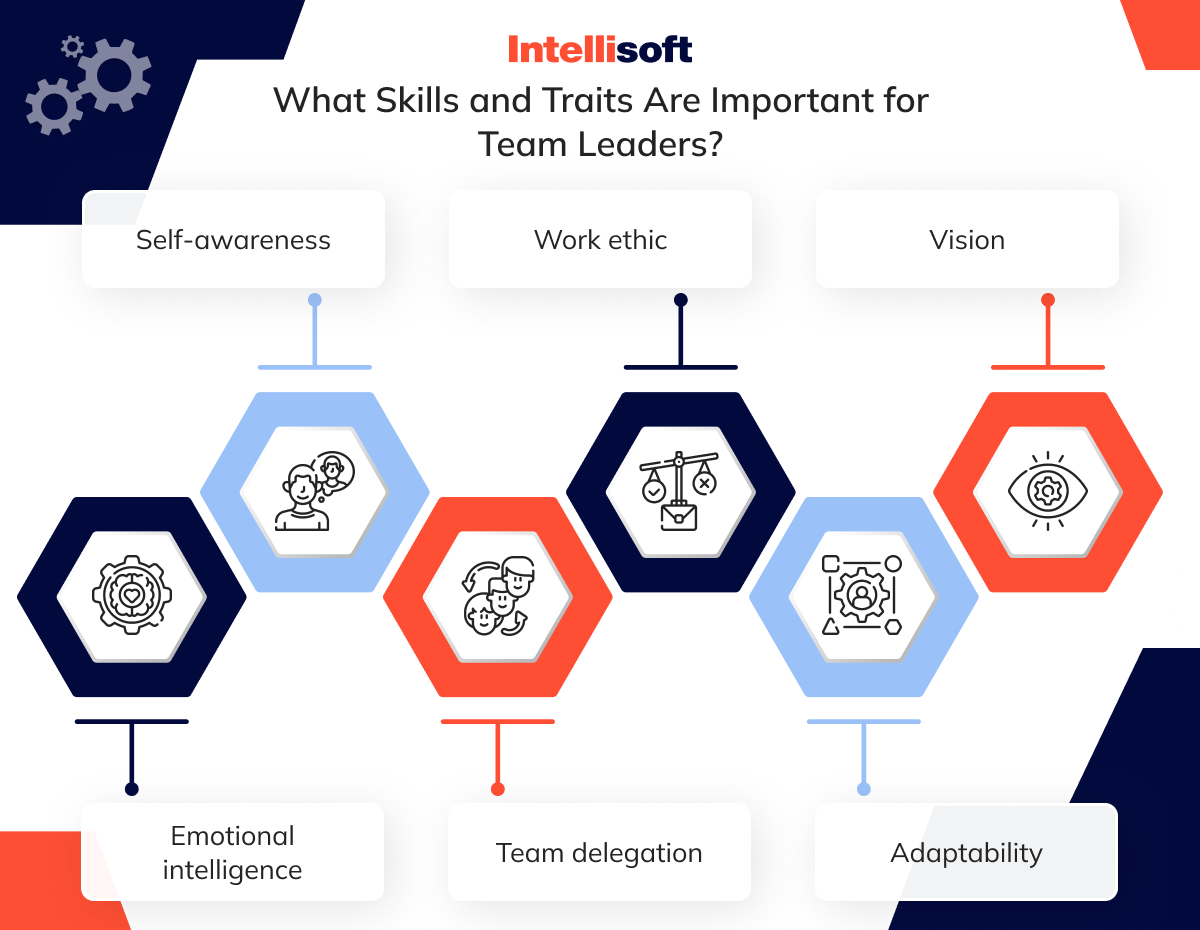Have you ever wondered why certain teams operate seamlessly and achieve success while others find it challenging to establish a unified workflow? The secret often lies with a key figure: the team lead. At IntelliSoft, where we specialize in creating dedicated software development teams, we’ve seen the power of strong leadership. What is a team lead? Leaders do more than just manage; they inspire, solve problems, and guide their teams to great achievements.
In this article, we’ll explore team leader responsibilities and what it means to be in this position. We’ll look at unique qualities that set outstanding leaders apart. Understanding what is the role of a team lead is crucial whether you want to become one or improve your skills. With our experience in optimizing crew dynamics in various industries, we can help you transform your leadership approach. Why settle for average when you can lead your personnel to its full potential?
Table of Contents
What Is a Team Lead Role?
What is the purpose of a team lead? He or she becomes a crucial figure in a modern business environment. They blend guidance with action, becoming the linchpin in the wheel of progress. A true leader isn’t just another part of the machine. They are vital, driving the crew towards organizational goals. What is a team lead responsibilities? Their main responsibility is to offer hands-on leadership. They work alongside their colleagues to turn strategic visions into real results.
As Steve Jobs once said: “My job is not to be easy on people. My job is to take these great people we have and to push them and make them even better.”

Why Do We Need Team Leaders?
Consider a group where every member is a specialist, highly skilled, and efficient. These experts might struggle to work towards a common goal without a leader. Team leader job responsibilities include bringing together diverse talents and ensuring each member’s strengths contribute to the project’s success. They are strategists for the short term, focusing on daily or weekly goals that build up to long-term achievements. Their presence ensures that large operations keep a human touch and that tasks are personalized and effectively directed.
Team Leader vs. Manager
The terms “team leader” and “manager” are often used interchangeably, but they mean different things. Managers focus on broader strategic goals and oversee multiple departments. They have the authority to reshape crews, set long-term goals, and ensure the company’s mission is clear throughout the organization.
Team leaders, on the other hand, work closely with their colleagues. They serve as a conduit between the staff and upper management, championing the needs of their team while fostering an atmosphere conducive to growth and innovation. Unlike managers, team leaders don’t usually have the power to hire or fire. Instead, they motivate and engage their crews daily.
Team Leader vs. Tech Lead
There are also differences between a team leader and a tech lead. A crew leader focuses on people management. They ensure cohesion, resolve conflicts, and create a positive atmosphere for development. They need strong interpersonal skills and emotional intelligence to inspire their people.
A tech lead focuses on the technical side of the project. They need a deep understanding of programming and specific technical skills to guide their crew through challenges. They ensure that all technical aspects align with the project’s goals.
Manager vs. Supervisor
Managers and supervisors also play crucial but distinct roles. Supervisors handle the operational side, directly interacting with the workforce and ensuring daily tasks are completed efficiently. They resolve conflicts and maintain workflow integrity.
Managers operate at a higher level, aligning the organizational strategy with outputs. They work with other managers and supervisors to translate the company’s broader goals into specific tasks, which supervisors then implement with their groups. Understanding these roles is essential for project success and dynamics.
What Are the Roles of a Team Leader?
The roles and responsibilities of a team leader extend well past conventional limits. They combine various leadership aspects to ensure their project runs smoothly. At the core, they act as the manager or supervisor, coordinating all activities. They make sure each member’s work aligns with the project’s goals. But their role involves much more than just overseeing tasks.
The Strategist
Leaders are also strategists. They plan out how tasks should be approached and completed. This strategic planning is crucial for guiding the group toward achieving project milestones and organizational goals.
The Communicator
Communication is vital in any project. The group leader serves as the main channel for all information. They ensure information flows smoothly between crew members and stakeholders. This role involves sharing information and creating an environment where open communication can proactively solve potential issues. In the context of roles of a superior team leader, “relating” refers to the ability of a leader to establish and maintain positive relationships with members.
The Organizer
Organization is key, especially in complex projects like software development. Group leaders manage multiple elements—from tasks and deadlines to members and documentation. Their organizational skills maintain the project’s direction and guarantee that each member understands their duties and responsibilities.
The Goal Setter
Setting clear, achievable goals is one of the major roles of a leader in a team. Defining what the group needs to accomplish gives a sense of direction and purpose. These goals are not just about meeting deadlines but also about pushing the crew to achieve higher standards of quality and efficiency.
Bridging Technical Execution and Project Management
In software development, the leader’s role includes several key areas:
- Project Management
- Guidance and Mentorship
- Setting Standards and Procedures
- Technical Leadership
- Customer-Centricity
They oversee project planning, execution, and timely delivery, ensuring everything stays within scope and budget. By mentoring group members, they create a learning environment that helps individuals overcome technical challenges and grow professionally. Setting precise standards and protocols is essential for upholding quality and uniformity in project outputs.
They lead on technical issues, ensuring the crew can handle complex problems and align solutions with business objectives. Focusing on customer needs is essential. Project team leader roles and responsibilities include adapting project goals as customer requirements change and ensuring the final product delivers value and satisfaction. Each of these roles highlights the essence of being a team leader. It’s a dynamic, multifunctional role crucial to the success of modern enterprises.
What Skills Do Team Leaders Need?
Successful leadership in the rapidly evolving software development sector demands many abilities. You need to be competent to take responsibilities as a team leader. These include technical knowledge, leadership abilities, clear communication, strategic problem-solving, and adept delegation. These skills are not just necessary but are the core competencies that enable group leaders to navigate their roles successfully.

Technical Expertise
A software development team leader must have strong technical expertise. They need a deep understanding of software development practices and the technologies their crew uses. This technical knowledge helps them make informed decisions, contribute meaningfully to technical discussions, and provide practical guidance throughout the project.
Leadership Abilities
Leadership is about motivating and guiding a group toward achieving goals. Effective leaders inspire confidence and enthusiasm. They create an environment where members are motivated to do their best. This involves setting achievable goals and maintaining high productivity through positive reinforcement and constructive feedback.
Strong Communication Skills
Communication is the bridge between vision and execution. Leaders need to articulate clearly and effectively with their team and stakeholders. This capability is vital for conveying project objectives, technical guidance, and plan modifications. Effective communication guarantees that all parties are synchronized and well-informed, boosting collaboration and minimizing confusion.
Problem-Solving Skills
In software development, challenges and obstacles are inevitable. Crew leaders need strong problem-solving skills to identify issues and develop effective solutions quickly. This ability is vital for ensuring project continuity and success. It allows leaders to handle crises efficiently and keep the project moving forward.
Delegation
Effective delegation is a key aspect of management. Skilled team leaders know how to assign tasks based on group members’ strengths and project needs. Proper delegation optimizes workload distribution and maximizes resource utilization. It guarantees that every member can contribute efficiently, cultivating a sense of responsibility and ownership.
These skills form the foundation of successful leadership in software development. They enable leaders to manage their teams effectively, complete projects on time and within budget, and deliver high-quality software products that meet or exceed expectations.
Related readings:
- Team Effectiveness Model To Maximize Collaboration
- Who Does What? Understanding Roles in a Software Development Startup
- Remote Development Team Structure in a Nutshell
- Make Your Projects Successful: Tips for Building a Powerful Project Team Structure
- In-House vs. Outsourcing Software Development Teams in 2024
Which Tasks are Responsibilities of the Team Leader?
Leading a group effectively involves much more than just overseeing tasks. It demands a proactive, engaged method to lead and assist team members. Here, we explore the fundamental team leader responsibilities.

Coaching Team Members
One of the main team leader duties and responsibilities involves coaching their crew members. This means helping them achieve their goals and develop the skills needed. Coaching goes beyond just giving instructions. It involves working alongside group members, providing continuous feedback, and setting an example of the desired skills and work ethic. This method guarantees that team members fulfill present standards and are prepared for upcoming obstacles.
Developing Team Strengths and Addressing Weaknesses
Understanding a team’s unique strengths and weaknesses is vital. Leaders can delegate tasks more effectively by knowing which members excel in specific areas. This awareness ensures the most capable hands handle each project component. Additionally, recognizing areas where the crew can improve and taking steps to enhance these skills is crucial for overall group development and efficiency.
Setting and Evaluating Team Goals
Defining what success looks like for the crew is a critical task. This role entails defining precise, quantifiable objectives and determining the methods for evaluating these goals. Frequent evaluation of the team’s advancement towards these objectives aids in sustaining focus and modifying tactics when necessary. This clarity prevents miscommunication and aligns crew members towards common objectives, fostering a collaborative work environment.
Resolving Conflicts
Conflict is inevitable in any group setting due to differing personalities, work traits, and motivations. Team leader qualities and responsibilities include managing and anticipating conflicts and resolving them effectively. Establishing clear ground rules and task assignments can prevent many conflicts. When conflicts arise, addressing them promptly and involving the concerned parties in the resolution process ensures they are resolved constructively, maintaining harmony and productivity.
Organizing Team Initiatives
Effective organization is crucial when multiple members work towards a unified goal. A leader must ensure that all aspects of the project—goals, communications, meetings, and important documents—are well-organized and easily accessible. This responsibility includes orchestrating work meetings and discussions to keep the team on track and aligned with the project’s objectives.
These team leader responsibilities form the backbone of effective leadership. By diligently fulfilling these roles, team leaders drive their people toward achieving specific goals and cultivate an environment conducive to growth, innovation, and sustained success.
Conclusion
The role of a team leader in software development is crucial. They bridge the gap between technical skills and strategic foresight. Competent leaders guarantee that projects adhere to rigorous quality criteria and align with overarching business objectives. Their ability to enhance productivity, streamline communication, and guide technical aspects of projects makes them indispensable in today’s fast-paced digital world.
By recognizing the importance of skilled team leadership, your organization can greatly benefit from outsourcing this key role. IntelliSoft is a leader in providing exceptional crew leader outsourcing services. Our software development teams consist of top-tier professionals with a wealth of experience and expertise. With IntelliSoft, businesses can quickly augment their teams with experts who excel in managing complex software projects.
By partnering with IntelliSoft, you ensure your projects are in capable hands. This allows your business to focus on its core strengths while enjoying a faster, more efficient development process. Whether you need agile adaptability for short-term projects or stability for long-term engagements, IntelliSoft’s outsourcing solutions offer a strategic advantage. Choose IntelliSoft to empower your projects with leaders who manage and elevate your team, driving your projects toward unparalleled success.










